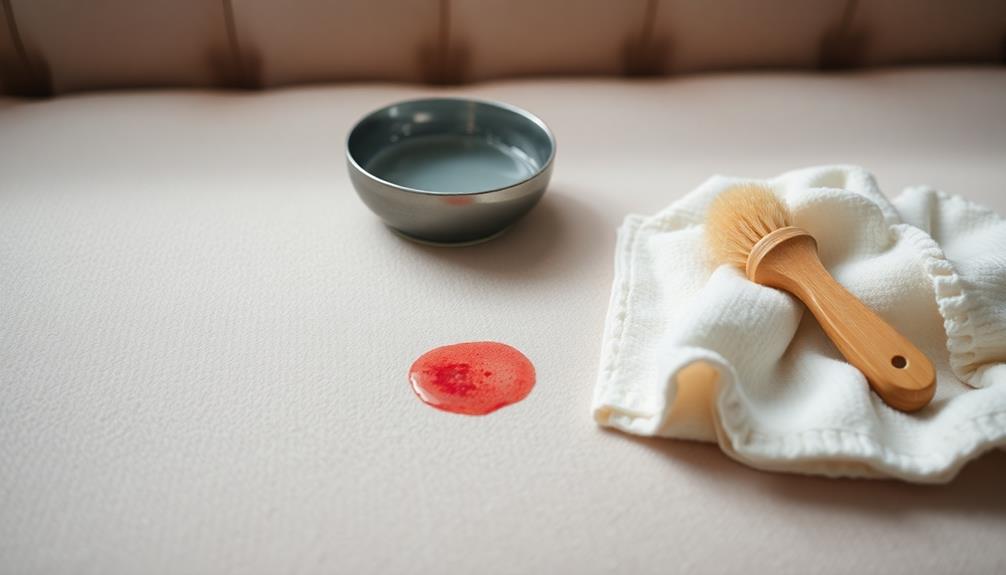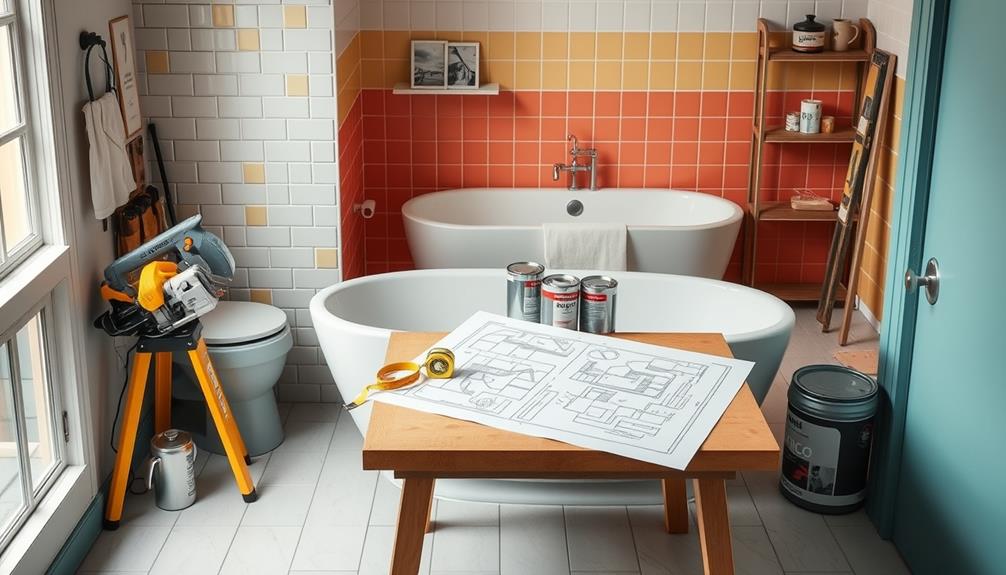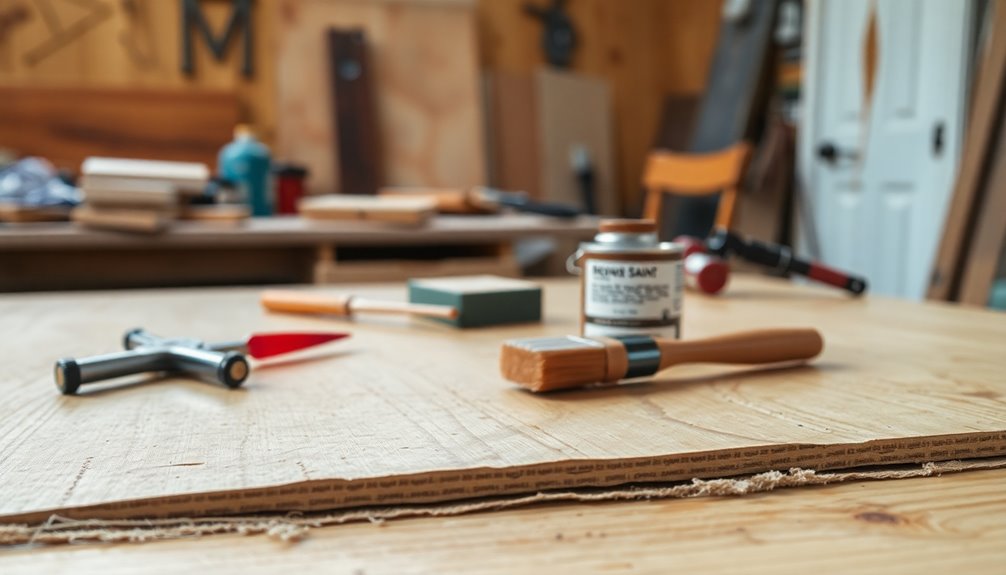To remove blood from your sofa effectively, it is important to act quickly! Blot the stain with a clean, dry cloth to soak up excess blood. Use cold water only, as warm water could set the stain. Gently dab the area with a cloth soaked in cold water. For stubborn or dried stains, a soft-bristled toothbrush can be used to help loosen it. You may want to try a mixture of cold water and gentle soap or natural remedies like vinegar or baking soda. Always test any cleaning solution on a hidden area first. With these tips, you can help keep your sofa looking fresh and clean. For more specific cleaning needs, such as removing dimethyl fumarate from sofas, it is crucial to use the right cleaning techniques. Dimethyl fumarate, a chemical sometimes present in furniture, may require a specialized approach, so seek professional advice if needed. By following these proper steps, you can effectively preserve the appearance and safety of your sofa.
Key Takeaways
- Blot the blood stain immediately with a clean, dry cloth to absorb excess blood without rubbing.
- Use cold water and a cloth to gently dab the stained area; avoid warm water as it can set the stain.
- For dried stains, gently loosen the stain with a soft-bristled toothbrush before applying cleaning solutions.
- Test cleaning solutions like vinegar or hydrogen peroxide on a hidden area to ensure no damage occurs to the fabric.
- If stains persist or the fabric is delicate, consider seeking professional cleaning services for expert assistance.
Understanding Blood Stains
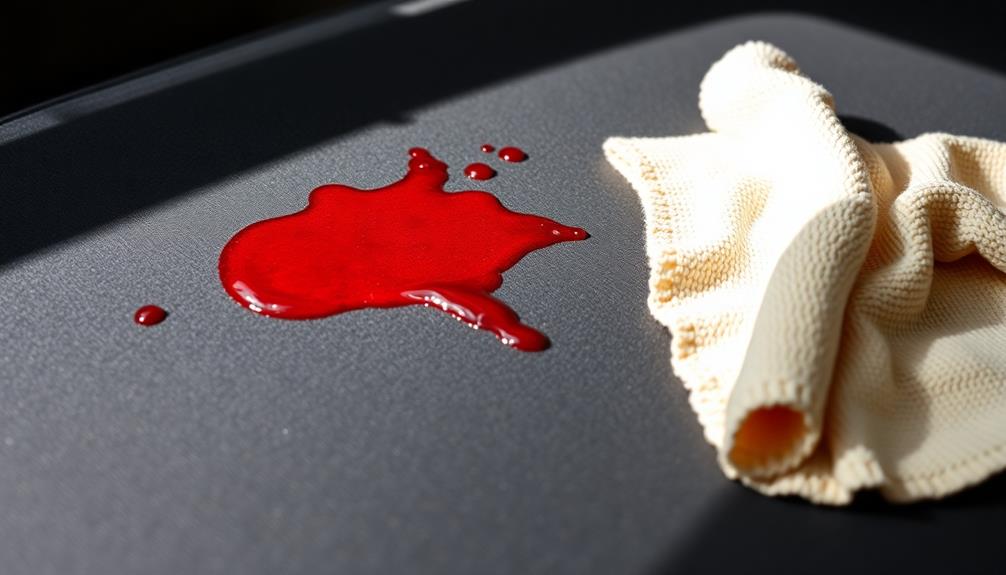
When it comes to dealing with blood stains on your sofa, understanding the nature of these stains is essential. Blood, whether from a minor injury or period blood, can be a common occurrence on upholstery.
It's important to remember that these stains aren't inherently dirty; they just require prompt attention for effective cleaning. For effective relief from other minor injuries that might cause such stains, consider common types of cold medications that can alleviate symptoms.
Quick action is vital because allowing blood to set can make the stain tougher to remove. Your emotional response—like embarrassment or frustration—might mirror reactions to other minor injuries, such as nosebleeds.
However, recognizing that blood stains are similar to other types of stains can help normalize the situation and motivate you to take action.
Knowing the characteristics of blood stains, including their color and consistency, can guide you in selecting the best cleaning methods. For instance, fresh blood stains tend to be brighter and easier to tackle, while dried stains can be darker and more challenging to remove.
Immediate Treatment Steps
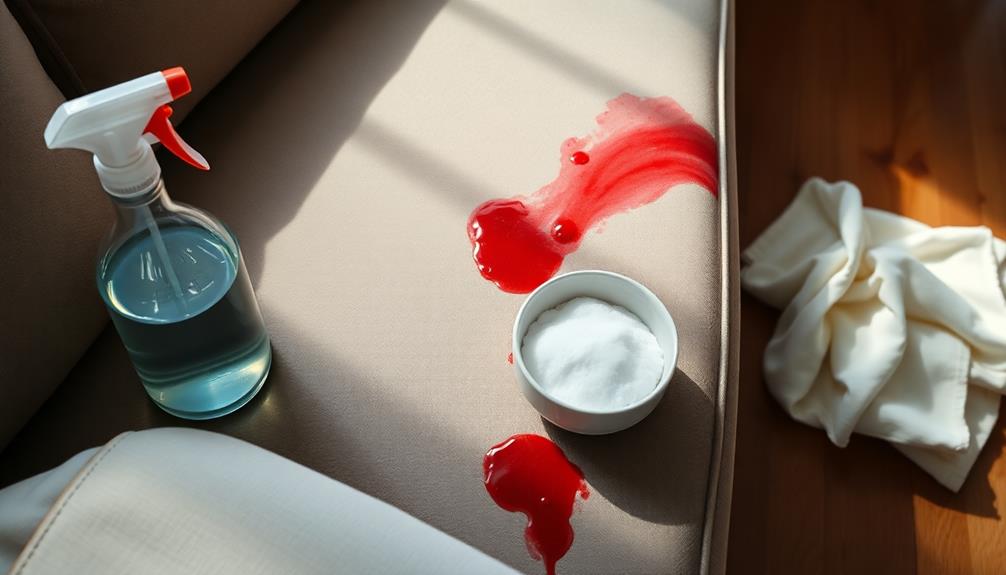
Prompt action is key to effectively treating blood stains on your sofa. Start by quickly blotting the stain with a clean, dry cloth to absorb excess blood. This helps prevent the stain from spreading further.
Remember, you should only use cold water; warm water can set the stain deeper into the fabric. Gently dab the stained area with a cloth soaked in cold water to aid in removing blood stains. For cleaning tips and techniques that can enhance your cleaning process, consider exploring various resources.
If the blood has dried, take a soft-bristled toothbrush and gently scrub the area to loosen the stain without damaging the upholstery. After that, mix cold water with a few drops of dishwashing liquid.
Apply this solution to the stain, blotting until you see the stain lift. It's essential to rinse the area with cold water afterward to remove any soap residue.
Throughout this process, always check the care label on your sofa. It'll tell you the appropriate cleaning methods based on the fabric type (W, S, SW, or X). Taking these immediate steps can greatly improve your chances of successful stain removal.
Cleaning With Soap and Water
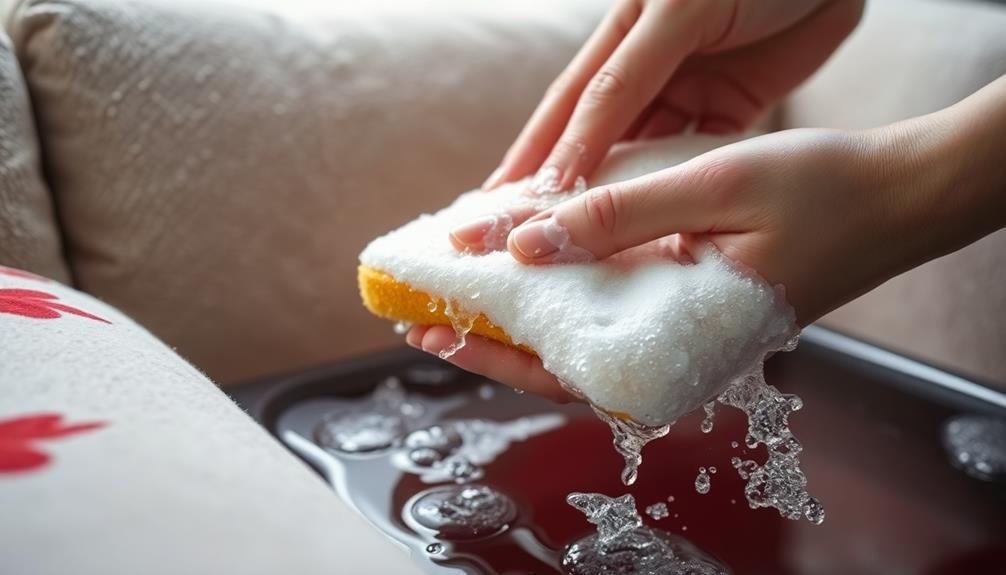
Cleaning blood stains from your sofa can be straightforward if you use the right techniques. Start by dampening a clean cloth with cold water; avoid warm water, as it can set the stain into the fabric.
Once your cloth is wet, apply a drop or two of regular soap. Gently dab the stain with the soapy cloth, lifting it without spreading it further. Remember that maintaining a budget for home care supplies can help you manage costs effectively, especially for unexpected cleaning needs like these effective budgeting tips.
For tougher stains, consider mixing vinegar or hydrogen peroxide, but always test this solution on an inconspicuous area first to avoid damaging your sofa. Continue to blot the stained area repeatedly with the damp cloth until the stain lifts. This method helps to guarantee you're not just moving the stain around but effectively cleaning it.
After you've removed the stain, dry the area with a clean, dry cloth. This step is vital to prevent moisture buildup, which could lead to mold or mildew.
Natural Solutions for Stains
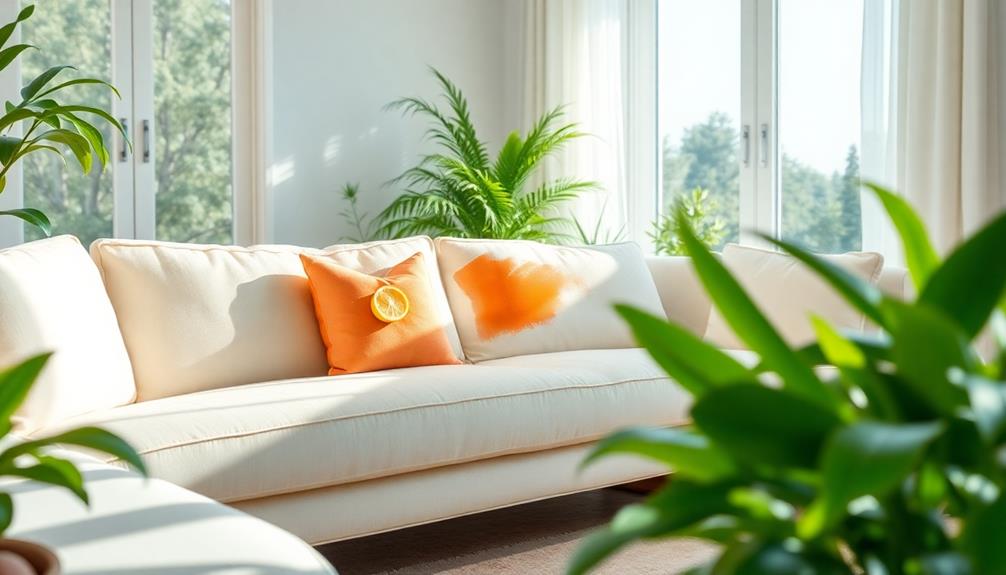
For those who prefer natural solutions, various household items can effectively tackle blood stains on your sofa. One powerful option is salt. Create a thick paste with salt and water, apply it directly to the stain, and let it sit for a few minutes before cleaning.
Additionally, essential oils such as tea tree oil, known for its antimicrobial properties, can help prevent any potential infections that may arise from the stain. Baking soda can also work wonders. Mix it with water to form a paste that lifts stubborn stains due to its alkaline nature.
Vinegar, a well-known natural cleaning agent, is another great choice. Combine equal parts of vinegar and water, apply it to the stain, and blot with a clean cloth to remove the blood.
If the stain persists, you can try hydrogen peroxide, which acts as a mild bleaching agent. Apply it directly to the stain and watch for a foaming reaction that helps lift the blood out of the fabric.
Always remember to test any natural cleaning solution on an inconspicuous area of the upholstery first to ascertain it doesn't cause damage or discoloration.
With these natural cleaning solutions at your disposal, you can tackle those stubborn stains effectively and safely.
Specialized Stain Removers
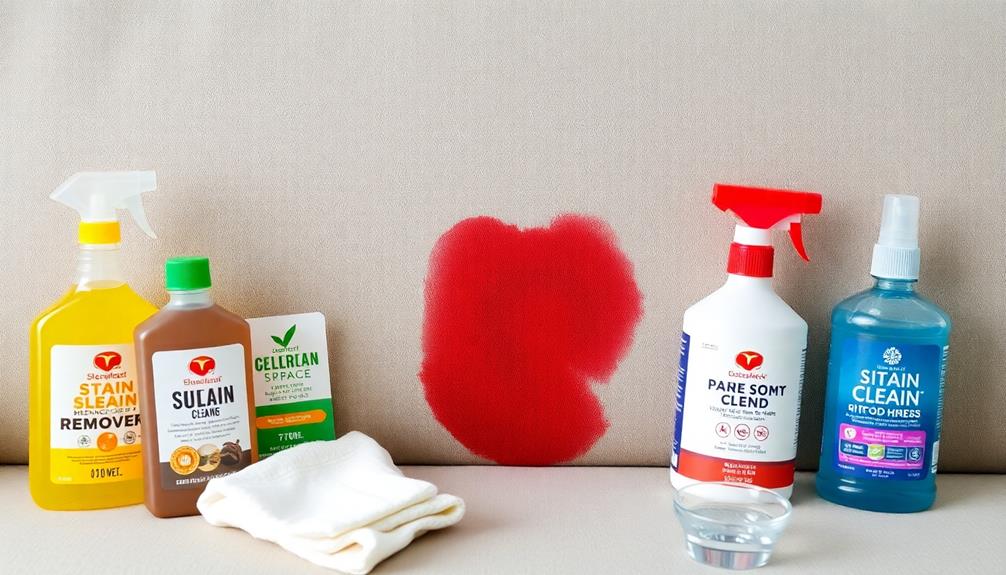
When it comes to tackling blood stains on your sofa, specialized stain removers offer targeted solutions that can be more effective than natural alternatives. Products like remūvie™ are excellent choices, as they're plant-based and fragrance-free, designed specifically for intimate stains.
To use remūvie™, simply spray it directly onto the stain and let the foaming action lift the blood. After a few moments, dab the area with a wet cloth for ideal results. For those who are new to pet ownership, understanding proper care for pets can help in preventing stains from occurring in the first place.
For stubborn blood stains, consider specialized stain removers that contain hydrogen peroxide or enzymes. These ingredients break down the proteins in blood more effectively, making it easier to remove tough stains.
Always remember to perform a patch test on an inconspicuous area of your fabric before applying any stain remover, guaranteeing you don't accidentally damage your upholstery.
Regularly stocking specialized stain removers in your cleaning supplies, especially in shared spaces like offices, promotes a period-positive culture and prepares you for unexpected stains.
If the stain persists despite your best efforts, you might want to call in professionals for Professional Upholstery Cleaning to guarantee your sofa stays in top shape.
Techniques for Different Upholstery
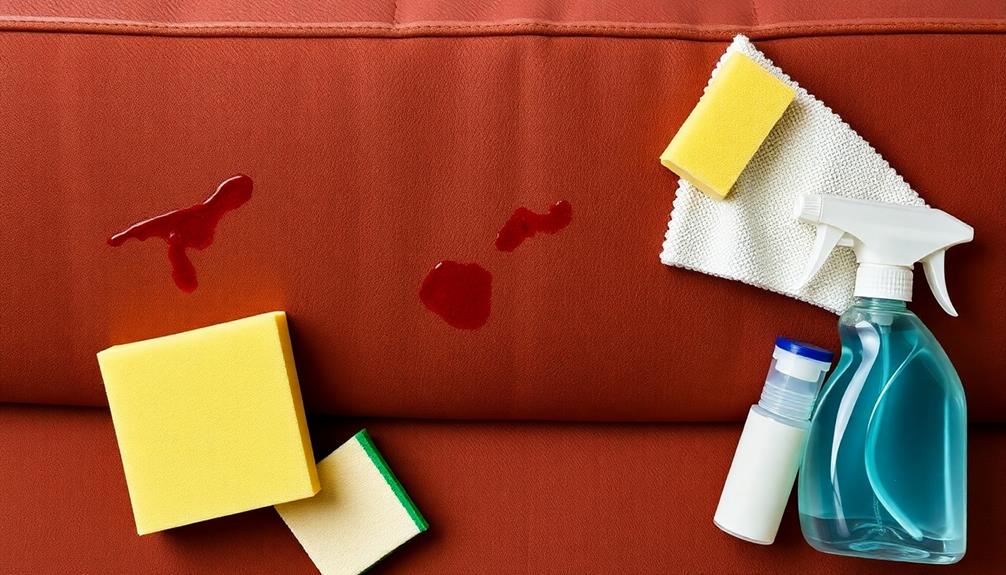
Since each upholstery material has its own cleaning requirements, knowing how to treat blood stains effectively is essential.
For a fabric sofa made of cotton or polyester, you can easily remove blood stains using a mixture of cold water and mild soap. Gently blot the stain, being careful not to rub it, as this can spread the blood.
Additionally, maintaining a clean air environment with an air purifier can help minimize allergens and bacteria that may affect your upholstery's longevity and cleanliness, especially when using techniques for air purifier maintenance.
If you're dealing with wool upholstery, mix cold water with vinegar to lift the stain, since wool can be sensitive to heat and harsh chemicals.
For synthetic fibers like nylon, a combination of water and dish soap works well without damaging the fabric.
However, always check the care label on your upholstery first. If it's marked with "X," you'll need to vacuum instead of using any liquid cleaners.
For delicate fabrics like silk or velvet, it's wise to test any cleaning solution on a hidden area to avoid discoloration.
If you feel unsure about tackling the stain yourself, don't hesitate to reach out to professional cleaning services. They've the expertise needed to remove blood stains safely without risking damage to your upholstery.
Testing Cleaners Safely
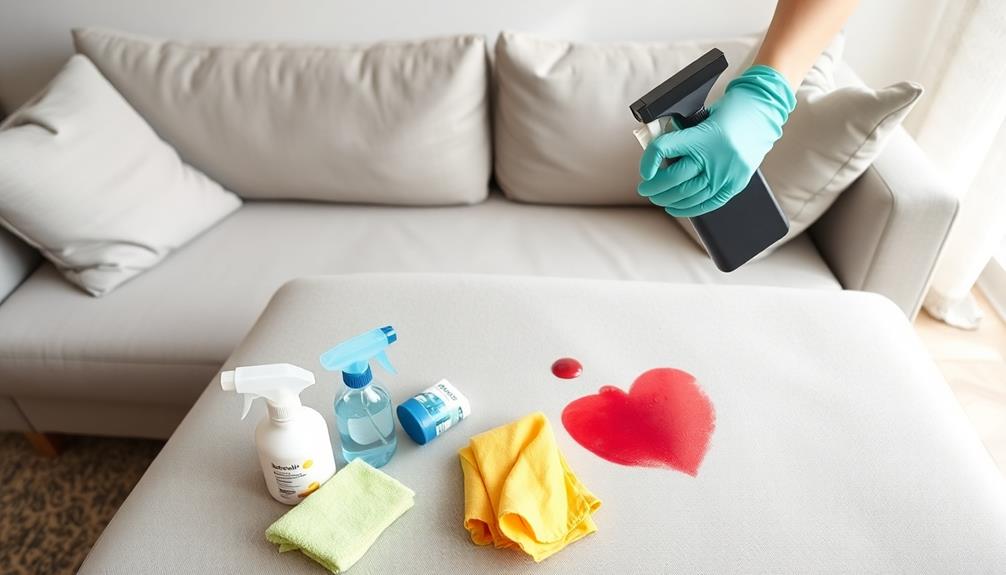
Before you start cleaning, it's essential to test any cleaner on a hidden area of your sofa.
This is especially important if your sofa is made from materials that could react poorly to certain chemicals, as noted in the appliance maintenance plans which emphasize the need for careful handling of various fabrics.
This patch test helps you spot any adverse reactions, ensuring you don't damage the fabric.
Remember to wait at least 24 hours to see how the material reacts before tackling the blood stain.
Importance of Patch Testing
Patch testing is an essential step in cleaning your sofa, ensuring you protect its fabric from potential damage. Before applying any cleaner to the affected area, always test your chosen solution on a small, inconspicuous spot. This simple practice helps prevent any adverse reactions like fading or discoloration.
Additionally, using a vacuum with a strong filtration system can help remove any dust or allergens before you begin the cleaning process, making it more effective, especially for those prone to allergies Best Vacuums for Dust Removal in 2024. Leave the cleaner on the test area for 24 hours to observe any changes. This timeframe allows you to see if the cleaner is safe for your specific fabric type.
Suitable cleaners for patch testing include upholstery cleaner, vinegar, baking soda, and hydrogen peroxide, depending on your fabric's care label guidelines (W, S, SW, X).
Understanding these guidelines can greatly impact the effectiveness of your patch testing. Consistent patch testing is vital for maintaining your upholstery's integrity and ensuring your selected cleaning method is both safe and effective.
If you're uncertain about the right products or methods, consider consulting a professional sofa cleaning service for expert advice. By taking these precautions, you'll not only protect your sofa but also make the cleaning process much smoother and more effective. Additionally, deep cleaning your sofa periodically can help extend its lifespan and maintain its original appearance. Regular maintenance, combined with deep cleaning, ensures that dust, allergens, and stains are effectively removed, keeping your living space fresh and hygienic. Ultimately, a well-maintained sofa contributes to a comfortable and inviting home environment.
Recommended Testing Areas
Identifying suitable testing areas on your sofa is key to safely cleaning it. Before you start, check the care label to determine the fabric type, as different materials may require different cleaning methods. Look for a hidden area, like underneath a cushion or on the back of the sofa, to perform your patch test.
For those with sensitive skin, consider choosing cleaning products that are less likely to cause irritation, similar to how aftercare is essential for body piercings to prevent infection and irritation. Use a clean, white cloth or sponge to apply the cleaner in this inconspicuous spot.
After applying the cleaner, observe the area for any adverse reactions, such as fading or damage, over a 24-hour period. If you don't notice any issues, it's safe to proceed to the stained area.
When you apply the cleaner to the stained area, follow the recommended method for best results. Remember to document any successful cleaning methods or products you've tested, as this can save you time and effort in the future.
When to Seek Professional Help
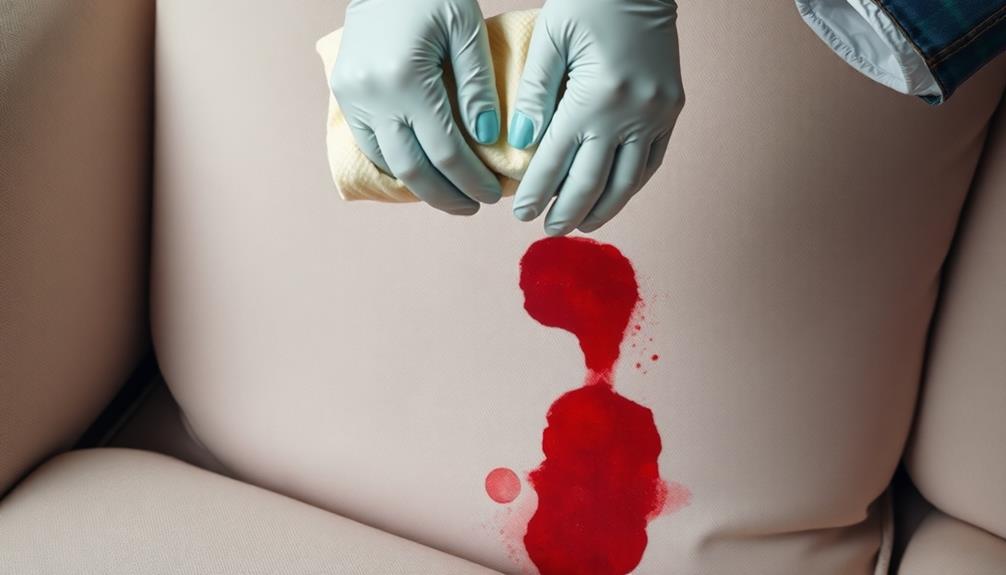
Blood stains on your sofa can be particularly stubborn, and knowing when to call in professionals can save you time and prevent further damage.
If you've tried your best to remove the stain with DIY methods without success, it may be time to seek professional help. Understanding the importance of financial considerations for elderly care can also be beneficial, especially if you're dealing with valuable furniture.
Here are three key indicators to take into account:
- Extent of the Stain: If the blood stain is extensive or has set in for a prolonged period, it can be challenging to remove without specialized equipment.
- Type of Fabric: If your sofa is made of delicate fabric or a valuable material, using harsh cleaning solutions can lead to irreversible damage.
- Uncertainty: If you're unsure about the cleaning process or the right products to use, opting for professional services can give you peace of mind, knowing that your sofa is in expert hands.
Many professionals, like De Hygienique, offer consultations to assess the stain.
They can provide tailored cleaning solutions based on the fabric type and stain severity, ensuring your sofa receives the proper care it deserves.
Maintaining Your Sofa
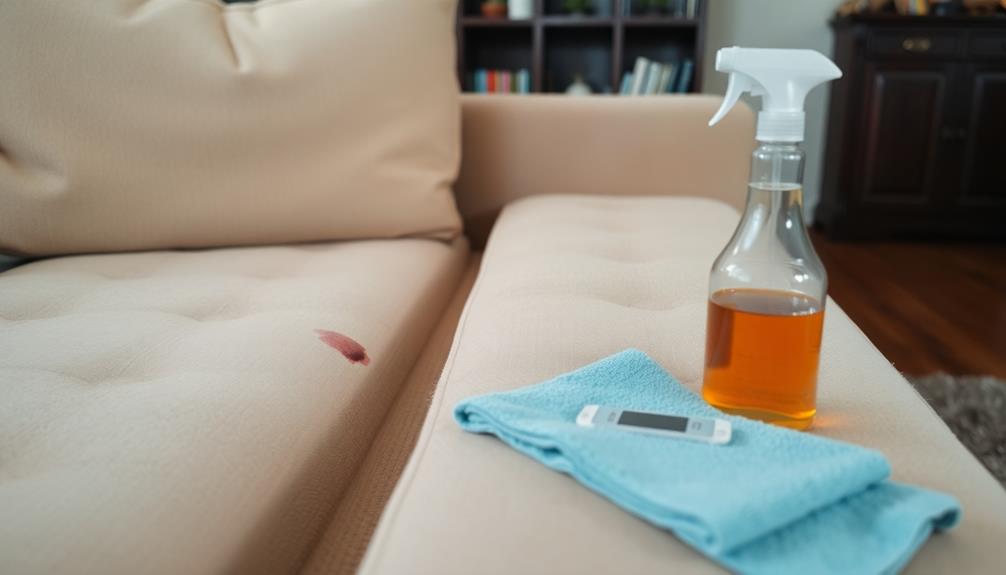
Once you've addressed any stains and confirmed your sofa is in good shape, maintaining it becomes your next priority. Regular upkeep will guarantee your sofa stays looking great for years to come. Start by vacuuming your sofa weekly to remove dust and debris, helping prevent stains from setting in. Using fabric protectors specifically designed for upholstery can create a barrier against spills, making cleaning easier.
Every six months, conduct a deep cleaning, using appropriate cleaning solutions based on your fabric type. Always keep a stain removal kit handy, including cold water, mild soap, and absorbent cloths, to tackle spills immediately.
Here's a quick reference table to guide your maintenance routine:
| Task | Frequency | Tools Needed |
|---|---|---|
| Vacuuming | Weekly | Vacuum cleaner |
| Deep Cleaning | Every 6 months | Cleaning solutions |
| Stain Treatment | As needed | Stain remover, absorbent cloths |
| Cushion Fluffing/Rotation | Monthly | None |
Additional Cleaning Resources
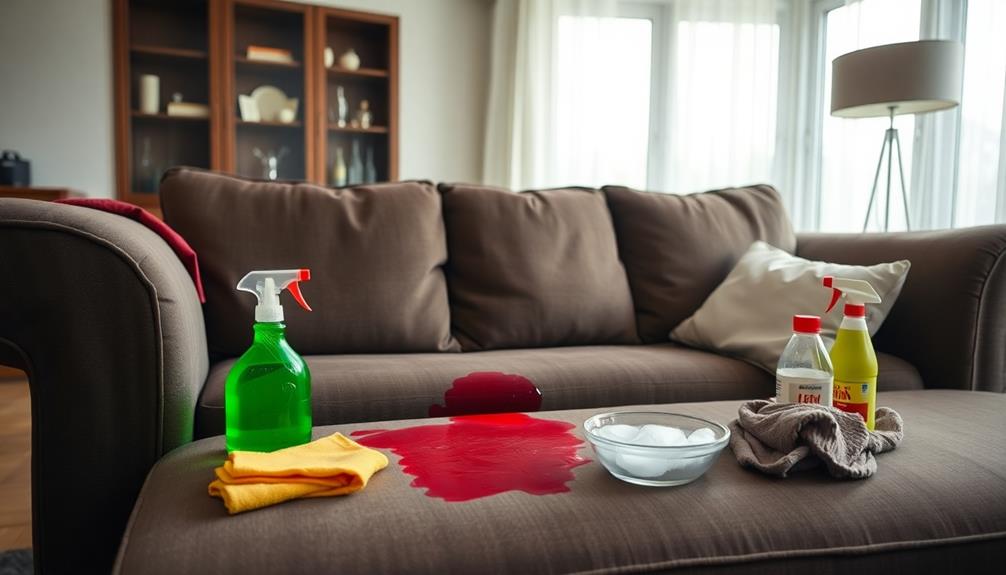
While tackling stains on your sofa, you might find it helpful to tap into a variety of additional cleaning resources.
These can enhance your stain removal efforts and help you maintain your upholstery. Here are three valuable resources to take into account:
1. Online Guides and Tutorials: Leverage step-by-step instructions for various stain removal techniques specific to upholstery.
Websites and video platforms often host expert advice that can guide you through the cleaning process.
2. Home Remedies: Explore eco-friendly cleaning solutions using common household items.
Ingredients like vinegar, baking soda, and dish soap can create effective cleaning products that are gentle on both your fabric and the environment.
3. Local Cleaning Services: Don't hesitate to check local cleaning service providers for promotions or discounts on professional stain removal services.
Sometimes, a professional touch can save you time and guarantee thorough cleaning.
Frequently Asked Questions
How Do You Get Blood Out of Fabric Sofa?
To tackle fabric stains, act fast. Blot the area with a clean cloth, use cold water, and apply a dish soap mixture. For tough stains, try a baking soda paste. Always test solutions first!
How Do You Get Dried Blood Stains Out of Fabric?
To remove dried blood stains from fabric, scrape off any hardened bits, then dab with a cold, damp cloth. For tough stains, try a baking soda paste or a glycerin solution for better results.
Does Hydrogen Peroxide Get Blood Out of Couch?
Did you know about 80% of people find hydrogen peroxide effective for stain removal? Yes, it can get blood out of your couch. Just apply it, watch for foaming, and blot the area afterward.
How to Get Period Blood Out of Couch Reddit?
To tackle period blood stains, you should immediately blot with cold water. Try a salt-water mix, or use a detergent solution. If needed, specialized stain removers can effectively lift tough stains from your couch.
Conclusion
To sum up, whether you're dealing with fresh stains or older marks, you can tackle blood on your sofa effectively. Act quickly, choose the right cleaning method, and test your cleaners safely. By using natural solutions or specialized products, you can restore your furniture's appearance. Remember, if the stain persists, don't hesitate to call in the professionals. With these strategies in hand, you'll keep your sofa looking great and feeling fresh for years to come!
